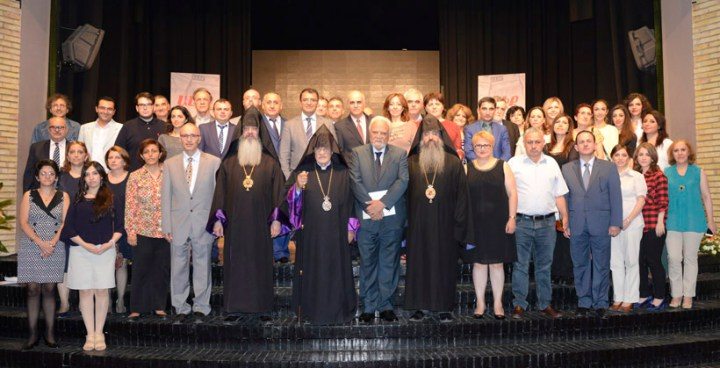Along with 16 other Armenian journalists from Armenia, Artsakh (Nagorno-Karabagh/NKR), the Czech Republic, France, Lebanon, Syria, and the United States, I was invited to attend the 85th anniversary celebration of Alik daily Armenian newspaper, published in Tehran since 1931.

As this was my first visit to Iran, I quickly discovered that the country was a lot different than what I had heard and read about in the United States. It is an important country with an ancient civilization that is often misunderstood by outsiders.
Tehran is a large city with millions of inhabitants trying to cope with the maddening traffic. Making matters worse, tens of thousands of motorcyclists zip around cars in every direction, while pedestrians dart through several lanes of heavy traffic, foolishly risking their lives. Basically, the scariest part of visiting Iran is neither the regime nor the militants, but the simple act of crossing the street!
I also found out that both Iranians and Iranian-Armenians are extremely hospitable, gracious, and polite. They go out of their way to help total strangers. Armenians, as a Christian minority, enjoy their full freedoms of education and worship. They have their own schools and churches all over the country. There are Prelacies of the Armenian Apostolic Church in Tehran, Isfahan, and Tavriz.
One of the stunning Armenian community centers is the Ararat Armenian Cultural Association’s center, which encompasses several acres of sports facilities, including a soccer stadium, basketball and tennis courts, swimming pools, and a chapel in the one of the most prestigious parts of Tehran. Our visit to Iran coincided with the opening ceremonies of the 48th annual Pan-Armenian games with Armenian scouts and athletes participating from various parts of Iran, Armenia, Artsakh, and Javakh, Georgia. The next day, Azerbaijan’s Embassy in Iran dutifully complained to the Iranian government about the inclusion of athletes from Artsakh in the Pan-Armenian games.
Iranian-Armenians serve as a vital bridge between their twin homelands: the Islamic Republic of Iran and the Republic of Armenia. Despite Azerbaijan’s complaints and its persistent efforts to undermine relations between Armenia and Iran, the Iranian government steadfastly maintains a balanced relationship with the two neighboring states. Armenia’s Ambassador to Iran, His Excellency Ardashes Toumanian, a highly competent and seasoned diplomat, is another important link between the Republic of Armenia, the government of Iran, and the local Armenian community.
The management of Alik newspaper had organized a hectic schedule for the incoming journalists which included visits to Armenian schools, an Armenian medical clinic, the Gulestan Palace, the Royal Jewelry Museum, and the Charmahal Society Center, where a talk-show was held for the community. The journalists also met with the Armenian National Committee (ANC) of Tehran, the Armenian Embassy, the Armenian Cultural and Athletic Association, two major Iranian media outlets, the spokesman for the Foreign Ministry, the Minister of Culture, and the Institute for Political and International Studies. The visitors were received everywhere with much warmth and respect.
The visiting journalists had also the pleasure of meeting with the two Armenian members of the Iranian Majlis (Parliament) who play a key role as the intermediary between the government and the Armenian community.
Last Saturday night, the journalists attended the official celebration of the 85th anniversary of Alik where they took the podium to congratulate the unique accomplishments of the newspaper that has educated and informed several generations with great sacrifices by dedicated editors, journalists, staff, benefactors and community organizations.
The highlight of the visit was the tour of the historic cities of Isfahan and Tavriz, including a special ‘pilgrimage’ to the ancient monasteries of Sourp Tadeh and Sourp Stepanos monasteries.
The most emotional part of the trip was driving along the Arax River on the border between Iran and Nakhichevan, formerly a part of Armenia, currently an autonomous region of Azerbaijan. Many of the journalists had tears in their eyes as they observed across the border an empty field that used to be an ancient cemetery with thousands of Armenian Khachkars (cross-stones) which were cruelly destroyed by the authorities of Azerbaijan, thus committing a cultural genocide and a crime against humanity!
In recent decades, even though many Iranian-Armenians have immigrated to other countries, mostly Glendale, California, the bulk of the community remains deeply committed to doubling its efforts in order to continue its role as a critical bridge between Iran and Armenia!


What an insightful journey. I left Iran in 1978, and have never returned there. I hope I can go back there this year.
Hi Harut, glad you had an opportunity to visit and experience firsthand the culture and people that for close to 500 years have graciously hosted Armenians in their land.
Great article. It seems to me that Iran, when it concerns Karabakh, would rather have the current status quo as apposed to any settlement..The reason is that the Azeri-Turkish agenda is to enclose Armenia completely and Iran knows this.. The idea of returning the supposed 5 Azeri districts is folly as Karabakh loses it security border all together. And we all know Azeris cant ever be trusted, EVER. Not only that, returning land leaves Armenia’s southern Siunik region very vulnerable which is the only land line that Armenia has to Iran, leaving Iran under the whim of Turkey/Azerbaijan. Also a comprehensive settlement means foreign peace keeping troops stationed near Iran’s border, something it doesn’t want either. Iran has to play neutral but seems to be more on the Armenian side out of its pure political interest. Armenia needs to take full advantage of this.